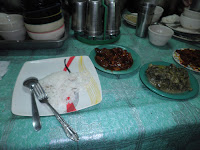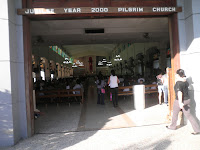Once you exit the Main Gate from the SBF zone, you will be on the famous Magsaysay Dr, where you can find all the restaurants, clubs and malls. It is the centre of entertainment in Olongapo City.
The stark contrast between the SBF zone and the city is glaringly evident here. The streets here are always busy with jeepneys, tricycles, motorbikes and cars. Fruit sellers with their makeshift trolleys, food vendors carrying baskets on their heads, and people, hordes of people, moving around. You can suddenly feel the excitement with so many things going on. There is even an old anti-aircraft gun mounted outside the American League post along the street.
Saw this lady carrying a basket of mashed cassava twists on her head walking by. Had to stop her and try. She carefully spread magarine on the twisted mashed cassava (tapioca), which was smooth and tasty. There are also stalls selling fried chicken innards and chicken blood on skewers.
The Olongapo City Public Market, situated along the Rizal Avenue, is full of colour and excitement. From vegetables to dry rations, from poultry to harvests from the sea, from groceries to fruits, and even stalls selling salt. There is a section for cooked food, another section for provisions such as pots and pans, mops and brooms and also a section for clothes and souvenir tee-shirts.
It was mango season, and the mangoes come from several different regions and in different sizes. Don't fall for the notion that bigger is sweeter. I found the medium-sized mangoes from the Candelaria Zambales region were the sweetest. The larger variety had more fibrous seeds, and carried a slight sourness.
Take a look at the fish head. It was bigger than the chopping board. And the roe crabs were so tiny, yet full of roe.
Just across the street from the Public Market is the Olongapo City Hall, and down the road in the opposite direction will lead you to the Ulo ng Apo Monument, from the legend that gave the city its name.
This is a busy intersection, as on one side is the Victory Bus Terminus and on the opposite side is where the St. Joseph's Catholic Church is located. While waiting for Mass on Sunday, we stopped by a stall that sells siomai, steamed meat dumplings which is a very popular snack in the Philippines, and tried some. They even serve a drink with green jelly in it, very similar to our local chin chow drink.
Just outside the church, we found a stall selling Putò
Bumbóng, sticky rice steamed in bamboo and eaten with coconut shavings and
brown sugar. It was interesting watching the old man make this delicacy. It was
very tasty too.
There are stalls selling all kinds of food along the streets
in front of churches, including fried spring rolls, salted nuts and fried
sausages and innards.
We also went by Marikit Park, along Rizal Avenue, on the way to Gordon's College. It is a small oasis in the middle of the city, featuring 2 American fighter air crafts on display. Just behind the park is Gordon's College.
One of the mornings, we went to the Pag-Asa Public Market along Gordon Avenue and had a typical local breakfast there. There were many dishes to choose from, including stewed pork, vegetable spring roll, braised intestines and nangka salad with crab. The food was very tasty and inexpensive.
The Pag-Asa Public Market is smaller than the City Public Market, but it also has a great variety of foodstuffs on sale. First time I see cucumbers that are actually light yellow in colour sold among bananas. There are also many different snacks and cakes on sale.
My favourite meal must be the one at Los Polluelos Lechon restaurant, which serves lechon baboy among other dishes. I simply cannot resist the roast pig. Crispy skin and succulent meat, with a delicious sauce, was really good.
We also had the Pritong Bangus (deep fried milkfish), another staple of the people there. Deboned and fried to crispy, the milkfish meat is smooth and delicious. All in all, a great dinner.
Just to share with you some of the sights and food I experienced while I was in Olongapo City. Life outside the Subic Bay Freeport Zone is very different, and you can see and feel the income divide of the people there.













































































































